
|
|
|
Introduction La forme extra pulmonaire de la tuberculose concerne surtout le rachis ; en particulier le rachis dorso-lombaire. La localisation cervicale est bien plus rare et constitue environ 3 à 5% des localisations rachidiennes (8,14,9). Elle peut intéresser le rachis cervical supérieur ou inférieur réalisant différents tableaux cliniques résultant de la compression bulbo-médullaire et associée à une atteinte de l’état général. Dans les pays à faible ou moyen revenu, son diagnostic peut être retardé et parfois basé sur une présomption radio-clinique. Le volet médical du traitement repose sur la chimiothérapie anti tuberculeuse à quatre puis 2 molécules durant 12 mois selon les protocoles qui peuvent différer en fonction des programmes nationaux. Le traitement chirurgical est controversé mais associe souvent une décompression médullaire à une stabilisation du rachis. Ce traitement peut être consolidé par la kinésithérapie. Nous rapportons ici le cas d’une jeune patiente traitée avec une issue favorable à un an de recul. Patiente et Observation Présentation clinique : Madame E. F. âgée de 36 ans, sans antécédents particuliers, a consulté le 06 août 2024 pour des cervicalgies évoluant depuis le mois d’avril 2024. En juillet 2024, sont apparues de façon rapidement progressive des difficultés à la marche dans un contexte de fièvre vespérale. L’examen physique avait noté une altération de l’état général avec un amaigrissement non chiffré, une tétraparésie à prédominance pelvienne et une baisse de la sensibilité tactile protopathique avec un niveau sensitif à L1. Il n’y avait pas à ce stade la présence de troubles sphinctériens. Le score de l’American Spinal Injury Association (ASIA) était de D. L’intra- dermo-réaction (IDR) à la tuberculine était positive à 20 mm et la vitesse de sédimentation accélérée à 89 mm à la première heure. La CRP était positive à 96 mg/ avec une anémie microcytaire à 9,7g/dl. Évaluation du diagnostic : l’imagerie par résonnance magnétique (IRM) du rachis cervical avait montré un processus lytique des vertèbres C-6 et C7, responsable d’une cyphose cervicale, centrée sur C6 et C7 avec épidurite antérieure comprimant le cordon médullaire cervicale et un abcès retro pharyngé (Figure 1). L’hypothèse d’une spondylodiscite tuberculeuse cervicale a été émise. Prise en charge : la patiente avait été mise sous traitement antituberculeux selon le schéma national. Un collier cervical a été mis en place. Une décompression médullaire cervicale avec stabilisation rachidienne a été indiquée. Nous avons réalisé un abord mixte postérieur (laminectomie C4-C7) et antérieur centré sur C6C7 qui a permis de ponctionner l’abcès pour un volume d’environ 60 cc de liquide jaunâtre et épais dont l’analyse bactériologique n’avait pas révélé la présence de germes. Nous avions également procédé à une stabilisation du rachis cervical par une arthrodèse par double cage cervicale et plaque visée de C5 à C7. La kinésithérapie motrice a débuté en post opératoire immédiat. L’examen anatomopathologique a observé des granulomes épithélioïdes et gigantocellulaires parfois centrés par une nécrose éosinophile anhiste évoquant en premier lieu une mycobactériose. La patiente avait poursuivi son traitement chimiothérapeutique antituberculeux pendant 12 mois : 2 mois de rifampicine – isoniazide – pyrazinamide – éthambutol (RHZE), suivis de 10 mois de rifampicine-isoniazide (RH). Résultats et suivi : Les suites opératoires immédiates ont été simples. La durée d’hospitalisation a été de 10 jours. L’évolution à 2 mois post opératoire a été marquée par la persistance de discrètes névralgies cervico-brachiales bilatérales C6 et C7 fugaces et intermittentes. A 3 mois post opératoire, on notait une bonne évolution clinique avec totale régression des douleurs cervicales et une récupération complète de la force motrice aux 4 membres. Au dernier contrôle à 1 an d’évolution post thérapeutique, la normalisation de la clinique s’était maintenue et le matériel d’arthrodèse était toujours bien en place. On note une fusion C6C7 (Figure 2). Un arrêt du traitement anti tuberculeux avait également été préconisé et la patiente avait déjà repris ses activités professionnelles. Déclaration de consentement du patient : les auteurs certifient avoir obtenu tous les consentements appropriés du patient. Discussion Dans notre contexte marqué par le retard au diagnostic et à la prise en charge des compressions médullaires lentes en général et celles d’origine tuberculeuse en particulier, réussir à traiter un patient dont l’évolution est finalement sans aucune séquelle neurologique peut ressembler à un exploit (3). Le tableau clinique du mal de POTT n’est pas spécifique et le délai diagnostique est très variable, pouvant s’étaler sur plusieurs mois, comme pour le cas présenté ici (2,11,7). Dans cette observation, la clinique de la patiente était faite d’un amaigrissement non chiffré, d’un syndrome douloureux rachidien cervical bas et d’un déficit neurologique. L’imagerie par résonnance magnétique (IRM) du rachis cervical en séquence pondérée T1 et T2 et T1 avec injection de Gadolinium a révélé une lésion destructive disco-corporéale antérieure intéressant C6 et C7, une cyphose cervicale et un abcès rétro pharyngé avec une extension de la collection suppurée dans le canal rachidien, compressive sur la moelle cervicale. La clinique, le bilan biologique et l’imagerie permettent souvent une forte présomption diagnostique qui, dans notre contexte peut faire déclencher le traitement antituberculeux et l’indication chirurgicale si elle est nécessaire. Il faut cependant souligner que le diagnostic de certitude est apporté par l’étude histologique (3). L’étude anatomo-pathologique des prélèvements du cas rapporté ici a confirmé l’origine mycobactérienne de la spondylodiscite. En fonction du délai d’évolution de la maladie avant la prise en charge, l’atteinte rachidienne peut être plus ou moins sévère allant d’une simple lésion disco-corporéale antérieure sans extension majeure intracanalaire à la dislocation rachidienne avec atteinte rachidienne multi étagée (1,10,4,13). Les antituberculeux restent la pierre angulaire du traitement du mal de POTT. Le schéma classique comprend 2 phases : une phase intensive de 2 mois avec une quadrithérapie et une phase de consolidation qui dure 10 mois avec une bithérapie (6). La chirurgie est recommandée lorsqu’il existe un déficit neurologique important, des lésions osseuses/ligamentaires importantes, une altération de l’équilibre sagittal, ou parfois une résistance aux médicaments. L’abord chirurgical est soit antérieur, postérieur ou combiné comme pour le cas rapporté ici (5,12). Ce geste chirurgical a permis de décomprimer la moelle cervicale, tout en assurant la stabilité rachidienne. Devant le refus de la patiente de réaliser un prélèvement osseux iliaque et à défaut de disposer d’un matériel de fusion synthétique, nous avons tenté de réaliser la fusion rachidienne entre C6 et C7 avec une greffe autologue issue de la laminectomie et sans corporectomie. Au contrôle à 1 an, C6 et C7 semblent avoir bien fusionné. Cependant, le contrôle radiologique mériterait d’être poursuivi. Conclusion La tuberculose rachidienne reste un problème majeur dans les pays à revenu faible et intermédiaire. Son dépistage précoce et son traitement doivent être un défi constant pour éviter les complications neurologiques sévères et les troubles de la statique rachidienne. Une issue favorable reste possible. Conflit d’intérêt Tous les auteurs déclarent ne pas avoir de conflit d’intérêt en lien avec cet article. 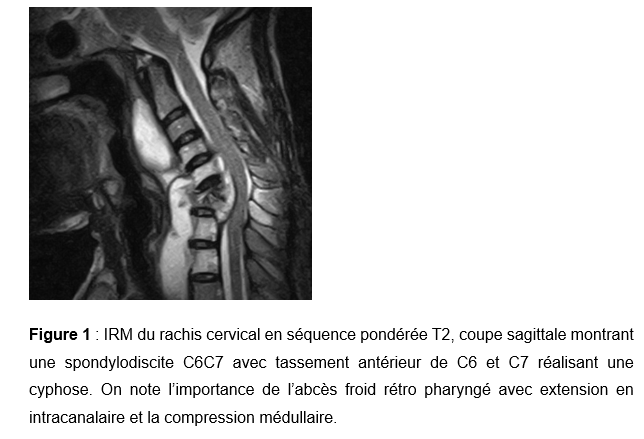 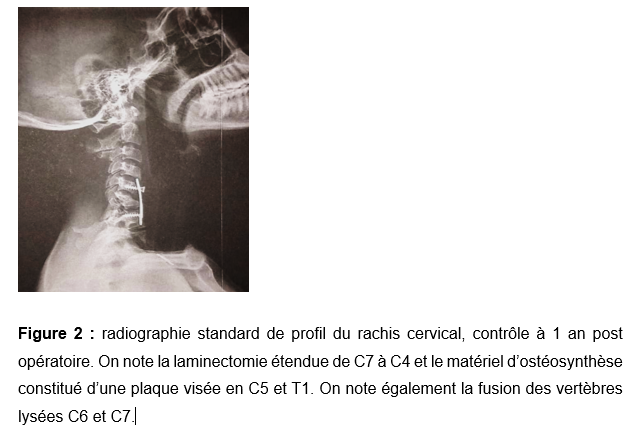 L’hydrocéphalie du nourrisson ou de l’enfant traduit une dilatation aigue ou progressive des cavités ventriculaires [5]. Elle aboutit à une souffrance cérébrale, voire une destruction du parenchyme cérébral avec de graves répercussions sur le développement psychomoteur et sur l’esthétique de l’enfant, constituant ainsi un véritable drame pour la famille [1]. Sa prévalence mondiale est estimée à 85/100000 naissances [9]. Dans les pays développés, sa prévalence est estimée entre 0,9 à 1,2 pour 1000 naissances vivantes. Dewan et al. rapporte une incidence d’hydrocéphalie congénitale de 79 à 123 pour 100000 naissances dans les pays à revenu faible et intermédiaire [6]. En Afrique subsaharienne, il y aurait environ 45000 nouveaux cas pédiatriques par an [10]. La survenue d’une hydrocéphalie engendre des désordres neurologiques nécessitant une prise en charge médico-chirurgicale rapide avant l’installation de séquelles neurologiques importantes. Elle implique des dépenses exorbitantes difficiles à supporter par les parents dans les pays à ressources limitées [8,14]. Au-delà de cette charge financière qui peut impacter négativement la qualité de vie sociale et conjugale des parents, se pose également le problème de la dépression dont sont fréquemment victimes les parents d’enfants porteurs de malformations ou de maladie chronique [3]. L’objectif de cette étude était d’évaluer les facteurs liés à la dépression et la qualité de vie des parents d’enfants atteints d’hydrocéphalie suivis à la clinique universitaire de neurochirurgie du CNHU-HKM de Cotonou. Méthodes Il s’est agi d’une étude transversale, descriptive et analytique avec collecte rétrospective et prospective des données allant de janvier 2018 à décembre 2023 (5 ans). Le critère d’éligibilité était d’être parent d’un enfant porteur d’hydrocéphalie suivi au CNHU-HKM. Nous avons recensé tous les cas d’hydrocéphalie pris en charge durant la période d’étude. Parmi cette population, nous avons sélectionné de façon exhaustive les parents joignables et qui étaient consentants. Un rendez-vous a été donné aux parents pouvant se déplacer vers le centre hospitalier pour l’entretien et pour les parents qui ne pouvaient pas se déplacer, l’entretien a été réalisé par appel téléphonique. L’entretien a été individuel et semi directif ; il était basé sur un guide d’entretien inspiré d’une étude portant sur le vécu psychologique des mères d’enfants atteints de handicap [7]. Ce guide a été soumis à l’appréciation d’un pédopsychiatre et d’un sociologue afin d’affiner les questions en tenant compte de nos réalités culturelles. Les variables dépendantes étaient la dépression et la qualité de vie des parents. L’inventaire de dépression de Beck (DBI) a été utilisé [2,15]. Il s’agit d’un questionnaire couramment utilisé en santé mentale pour évaluer la gravité de la dépression chez les adultes et les adolescents. Il comporte 13 questions portant sur les sentiments en faveur d’une dépression tels que : la tristesse, le pessimisme, la diminution ou la perte d’intérêt ou de plaisir dans la vie quotidienne, les perturbations du sommeil, la fatigue ou la perte d’énergie, les changements d’appétit, la perte ou le gain du poids, les sentiments de dévalorisation, de culpabilité ou d’inutilité, l’agitation ou le ralentissement psychomoteur, la diminution de l’aptitude à penser, se concentrer ou indécision , les pensées de mort ou de suicide. Le score total est la somme des 13 questions. Il varie de 0 à 39 et permet de classer le sujet en quatre groupes : 0-3 : pas de dépression ; 4-7 : dépression légère ; 8-15 : dépression d’intensité moyenne à modérée ; 16 et plus : dépression sévère. Le DBI a été rempli en présence des parents en leur expliquant les items pour limiter les biais de remplissage. La qualité de vie a été évaluée en auto évaluation par les parents eux-mêmes, puis objectivement par l’échelle de WHOQOL-BREF, qui est un instrument fiable et valide, recommandé pour estimer la qualité de vie d’une personne. Il comporte 26 questions et mesure 4 domaines, soit la santé physique, la santé mentale, les relations sociales et l’environnement. L’analyse se fait sur les scores générés pour chacun des domaines. [12] L’analyse a été faite à l’aide du logiciel R 3.6.1 avec l’environnement RStudio. Les paramètres de tendance centrale et de dispersion étaient utilisés pour décrire la population d’étude. La comparaison de deux moyennes sur séries indépendantes était effectuée au moyen du test t de Student. Les tests de comparaison de proportion étaient effectués à l’aide du test de Chi2 de Pearson, et en cas de non-validité de ce test, par le test exact bilatéral de Fisher. Le seuil de significativité était fixé à 0,05. Résultats La figure 1 montre le diagramme de flux de la série. Quarante-cinq parents avaient été questionnés, dont 28 mères (62,2%) et 17 pères (37,8%). L’âge moyen des parents était de 33,4 +/- 7 ans (22 ans et 49 ans). La grossesse était planifiée dans 66,7% des cas. Trente-cinq enfants (77,8 %) ont été opérés. Le coût moyen de la prise en charge était estimé à 457200 FCFA (environ 700 euros), soit plus de 8 fois le salaire minimum interprofessionnel garanti (SMIG) au Bénin. Trente-sept parents (82,2%) avaient un revenu mensuel inférieur ou égal au SMIG. Sur le plan matrimonial, 53,3% des parents étaient mariés. Le tableau I rapporte la répartition des parents selon leurs caractéristiques sociodémographiques. Les parents avaient apprécié leur qualité de vie comme étant faible dans 35,6 % des cas. La figure 2 montre l’auto appréciation de leur qualité de vie. Le tableau II rapporte la répartition des moyennes obtenues après correction par le WHOQOL-BREF de la qualité de vie des parents. Un désir de divorce a été formulé par l’un des partenaires dans 24,4% et il a été effectif dans 4,4% des cas. Au plan de la sexualité, 37,8 % des parents étaient insatisfaits ou très insatisfaits de leur vie sexuelle. Dans 17,8% des cas, les parents avaient très souvent des conflits concernant l’enfant. La situation de la vie de couple est rapportée dans le tableau III. L’annonce de la maladie avait constitué un choc émotionnel pour les parents dans 51% des cas et 20% d’entre eux avait réagi par le déni. Le ressenti des parents étaient marqué par la tristesse dans 53,3% des cas et un sentiment de culpabilité dans 31,1% des cas. La figure 3 présente le ressenti des parents suite à l’annonce de la maladie. La prévalence de la dépression était de 86,6% (39 parents). Elle était sévère chez 5 parents (11,1%) et modérée chez 20 parents (44,4%). En analyse bivariée, le principal facteur associé à la dépression était l’insuffisance de ressources financières (p=0,006). Le tableau IV montre la répartition des facteurs associés à la dépression. Discussion Techniques de collectes des données et formulaires utilisés Les techniques de collecte de données étaient adaptées, pour aider tous les enquêtés au remplissage du questionnaire et fournir toutes les informations (entretien semi directif). Elles ont permis aussi d’expliquer correctement les questions, d’éviter les mauvais remplissages, et d’avoir des informations plus complètes. Les échelles (Beck, WHOQOL-BREF) [1,2,15] utilisées dans notre étude sont validées dans la littérature. Il a cependant pu persister quelques biais de sélection (le consentement obligatoire limitait l’échantillon aux personnes accessibles et disposées à participer), des biais de mémoire liés au caractère partiellement rétrospectif de la série et aussi des biais de prévarication dus à la peur de jugement. Qualité de vie des parents Les pays à revenu faible et intermédiaire supportent la charge de morbidité la plus lourde en ce qui concerne l’hydrocéphalie de l’enfant, en particulier ceux des régions d’Afrique [6]. Le montant de la prise en charge est généralement au-dessus des capacités financières d’une bonne frange des populations. Le Bénin qui ne dispose pas encore d’une assurance maladie universelle n’échappe pas à la règle. Gandaho et al dans ses travaux avait montré qu’il existait un rapport de 13,50 entre les charges fixes (1 117 500 FCFA 1 777 euros) et les revenus moyens des parents (82 600 FCFA 120 euros) [8]. Il rapportait également qu’après l’hospitalisation, 31 mères avaient perdu leur emploi et 21 couples n’avaient plus envie de procréer. De même, 12 nouvelles séparations avaient été enregistrées. Dans cette étude, au cours de l’entretien, 35,6% des parents déclaraient avoir une faible qualité de vie lors de l’autoévaluation. Une évaluation plus objective, notamment à l’aide de l’échelle de WHOQOL-BREF, a permis de retrouver une moyenne de score transformé dont les valeurs étaient toutes faibles comparées aux valeurs moyennes données par l’équipe de création du WHOQOL-BREF. Ceci pourrait témoigner d’un impact réel de l’hydrocéphalie sur la qualité de vie des parents. A ce niveau cependant, le défi de disposer d’une échelle validée pour les populations africaines reste d’actualité. La dépression des parents La santé mentale des parents d’enfants porteurs de handicap lourd semble être un aspect de santé très peu renseigné dans la littérature africaine. La prévalence de la dépression, selon l’échelle de Beck, était de 86,6% dans notre série avec plus de 11% de cas sévères. Nika et al. et Ben Thabet et al, avait fait mention dans leur étude respectivement de 70,2% et 52% de cas de dépression, principalement chez les mères ; cette dépression semblait être corrélée à de faibles niveaux d’éducation socio-économiques. La dépression est un trouble mental courant constituant l’une des principales causes de handicap dans le monde et contribuant grandement à la charge mondiale de morbidité. On estime que 5 % des adultes en souffrent dans le monde. Elle est due à des interactions complexes entre des facteurs sociaux, psychologiques et biologiques [17]. Elle se caractérise par une tristesse persistante et un manque d’intérêt pour les activités quotidiennes et une incapacité à les mener. D’autres symptômes peuvent également être présents : perte d’énergie, modification de l’appétit, augmentation ou diminution du sommeil, anxiété, baisse de la concentration, indécision, agitation, sentiments de dévalorisation, de culpabilité ou de désespoir, pensées autodestructrices ou suicidaires [16]. Tous ces symptômes étaient présents à divers degrés chez les parents de notre étude. Cependant, aucun des parents n’avait mentionné avoir éprouvé des pensées suicidaires, peut-être parce que le sujet du suicide est tabou ou perçu comme honteux dans notre milieu socio-culturel, ce qui suscite la peur du jugement social. De plus, la religion continue également d’exercer une influence inhibitrice [11]. Gandaho et al rapporte un cas de décès maternel pour dépression [8]. Les parents des nouveau-nés malformés vivent un drame psychologique souvent ignoré des praticiens. Lorsqu’ils réalisent que leur enfant n’est pas conforme à leurs espérances, se produit en eux une succession de réactions émotionnelles variables dans le temps [13]. Au plan des relations sociales, les familles avec un enfant ayant une maladie handicapante sont dramatiquement coupées de la vie sociale. Lorsque les parents réalisent que leur enfant ne comblera ni leurs attentes, ni leurs aspirations et qu’il ne répondra pas davantage aux normes de la société, ils ont tendance à s’isoler pendant une certaine période. Au cours de notre étude, 37,8% des parents avaient déclaré s’être éloignés de leurs amis, et préféraient ne pas leur parler de la maladie de leur enfant ou des difficultés qu’ils rencontrent. Notons également que 22,22% se sont éloignés de leurs familles, ne leur rendaient plus visite et n’en recevaient plus. Cet isolement pourrait s’expliquer par la crainte de la stigmatisation, la moquerie de l’entourage et de la famille, la curiosité et la honte. La mise en place d’un groupe de parole pour le partage d’expérience entre les parents des enfants atteints d’hydrocéphalie pourrait s’avérer bénéfique et pourrait réduire l’isolement des parents. La nécessité de mettre en place une démarche fondée sur l’éthique d’une écoute respectueuse de la demande et une pratique pluridisciplinaire incluant un psychologue dans la procédure de l’annonce et la suite de la prise en charge apparaît incontournable [4]. Conclusion L’hydrocéphalie constitue un lourd fardeau psychosocial pour les parents au Bénin. Son annonce est une période difficile à vivre pour les parents et occasionne d’importants désordres psycho-sociologiques parmi lesquels la déception, la culpabilité, la colère, la honte et la dépression. Les mères peuvent faire l’objet d’une marginalisation et les parents se retrouver en isolement vis-à-vis de l’entourage familial ou professionnel. Les conflits conjugaux sont fréquents pouvant aller jusqu’à la séparation ou le divorce. Il est nécessaire de mettre en place une procédure de prise en charge incluant un soutien psychologique pour les parents. Conflit d’intérêt Les auteurs déclarent ne pas avoir de conflits d’intérêt avec le présent article. 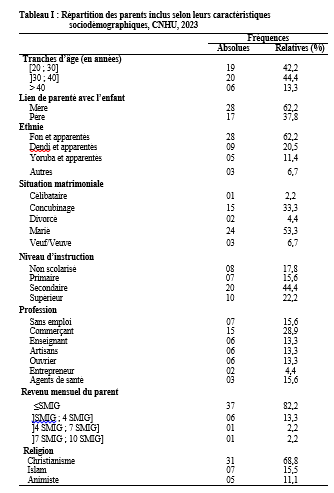 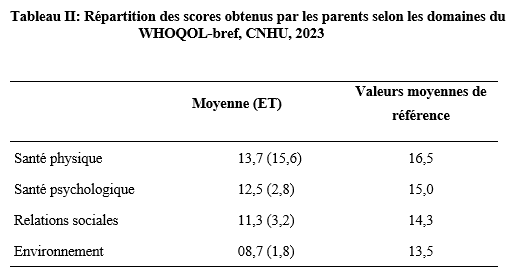 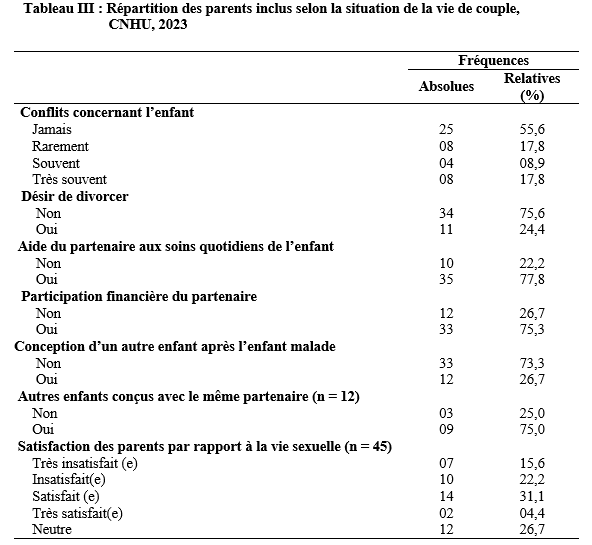 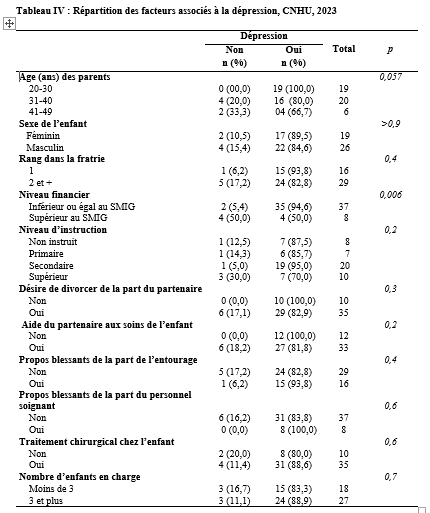  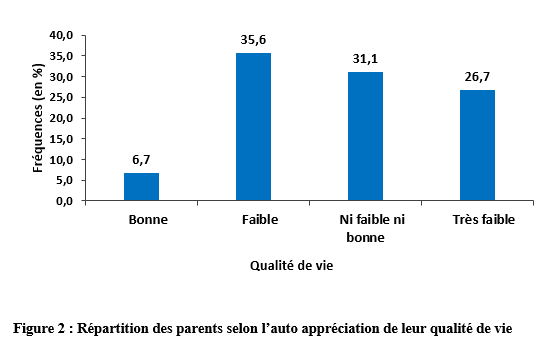 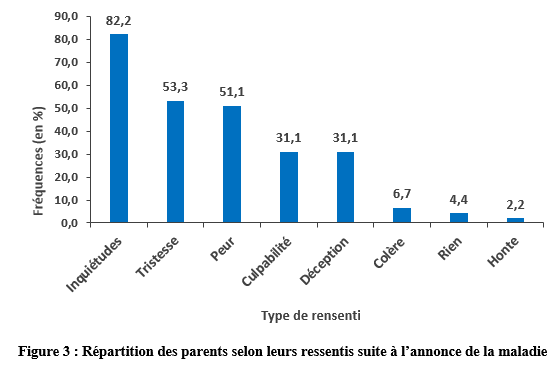 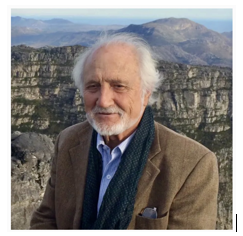 Le Professeur Michel Dumas, éminent neurologue, membre correspondant de l’Académie nationale de médecine, fondateur et directeur honoraire de « l’Institut d’épidémiologie et de santé mondiale Michel Dumas », s’est éteint discrètement à Limoges le 8 novembre 2025, à l’âge de 91 ans. Son départ laisse un vide immense dans les domaines de la neurologie tropicale, de la santé publique et de la coopération scientifique internationale. Né au Mali, il a grandi et étudié au Sénégal où il a été le chef de service de neurologie à Dakar. L’Afrique a été le continent qu’il portait au plus profond de lui-même. Arrivé à Limoges dans les années 70, il y a développé son expertise et son envergure scientifique. En 1981, il fonde l’Institut d’épidémiologie et de neurologie tropicale, qui, sous sa direction, devient une référence mondiale en neurologie et en santé publique. Son influence s’étend bien au-delà des frontières, formant des générations de neurologues africains francophones avant de s’élargir à la santé globale. En 2015, Prof. Dumas s’est vu décerner la médaille « pour service rendu à la neurologie internationale » par la Fédération Mondiale de Neurologie. En hommage à son héritage, l’institut porte aujourd’hui son nom : Institut d’Épidémiologie et de Santé Mondiale–Michel Dumas, symbole de la reconnaissance internationale de son action. Homme d’engagement et de conviction, le Professeur Dumas était connu pour sa gentillesse, son dynamisme, son exigence, son humanisme. Visionnaire, il a fait de Limoges un pôle d’excellence international, tout en œuvrant sans relâche pour renforcer les liens entre la France et l’Afrique. Il est l’auteur ou co-auteur de plus de 500 publications, chapitres de livres. Professeur Dumas a formé un grand nombre de neurologues dont plusieurs sont devenus professeurs en Afrique essaimant ainsi sur tout le continent des centaines de praticiens traitant les maladies du système nerveux. Comme il le confiait dans un journal français en mai 2022 : « J’ai voulu rendre à l’Afrique ce que j’avais reçu » Pendant quarante ans, ses équipes ont mené des recherches pionnières sur les maladies neurologiques tropicales, parmi lesquelles : – La trypanosomiase africaine, – L’épilepsie en zone tropicale, – Les démences liées aux contextes épidémiologiques spécifiques. Son héritage perdure à travers les nombreux médecins et chercheurs qu’il a formés, les études épidémiologiques qu’il a contribué à développer, et les ponts scientifiques qu’il a construits entre tous les continents. Que son souvenir reste vivant dans le cœur de ceux qui l’ont connu, et que son œuvre continue d’éclairer la médecine et la coopération internationale. Nos pensées affectueuses accompagnent ses enfants, ses petits-enfants et tous ses proches. Prof Gilbert Dechambenoît, Prof Kouassi Beugré, Prof Boa Yapo Félix, Prof Thérèse Sonan Douayoua, Prof François Akani, Prof Berthe Assi Obituary Professor DUMAS Michel (1934-2025) 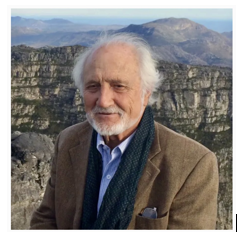 Professor Michel Dumas, eminent neurologist, corresponding member of the French National Academy of Medicine, founder and honorary director of the Michel Dumas Institute of Epidemiology and Global Health, passed away quietly in Limoges on November 8, 2025, at the age of 91. His passing leaves a huge void in the fields of tropical neurology, public health, and international scientific cooperation. Born in Mali, he grew up and studied in Senegal, where he was head of the neurology department in Dakar. Africa was the continent he carried deepest in his heart. Arriving in Limoges in the 1970s, he developed his expertise and scientific stature there. In 1981, he founded the Institute of Epidemiology and Tropical Neurology, which, under his leadership, became a global reference in neurology and public health. His influence extended far beyond borders, training generations of French-speaking African neurologists before expanding into global health. In 2015, Prof. Dumas was awarded the medal “for service to international neurology” by the World Federation of Neurology. In tribute to his legacy, the institute now bears his name: Institut d’Épidémiologie et de Santé Mondiale–Michel Dumas, a symbol of international recognition of his work. Professor Michel Dumas A man of commitment and conviction, Professor Dumas was known for his kindness, dynamism, high standards, and humanism. A visionary, he made Limoges an international center of excellence, while working tirelessly to strengthen ties between France and Africa. He is the author or co-author of more than 500 publications and book chapters. Professor Dumas trained a large number of neurologists, several of whom became professors in Africa, thus spreading hundreds of practitioners treating diseases of the nervous system across the continent. As he confided to a French newspaper in May 2022: “I wanted to give back to Africa what I had received.” For forty years, his teams conducted pioneering research on tropical neurological diseases, including: – African trypanosomiasis, – Epilepsy in tropical areas, – Dementia linked to specific epidemiological contexts. His legacy lives on through the many doctors and researchers he trained, the epidemiological studies he helped develop, and the scientific bridges he built between all continents. May his memory live on in the hearts of those who knew him, and may his work continue to enlighten medicine and international cooperation. Our affectionate thoughts are with his children, grandchildren, and all his loved ones. Prof Gilbert Dechambenoît, Prof Kouassi Beugré, Prof Boa Yapo Félix, Prof Thérèse Sonan Douayoua, Prof François Akani, Prof Berthe Assi LE COUT DE LA PRISE EN CHARGE DES ACCIDENTS VASCULAIRES CEREBRAUX DANS LES CHU DE LOME EN 2025Introduction Les accidents vasculaires cérébraux (AVC) constituent un enjeu majeur de santé publique de par leur morbi-mortalité et leur incidence sans cesse croissante avec une prévision de l’Organisation Mondiale de le Santé (OMS) de 16 millions de cas en 2005 à 23 millions en 2030 (4,10). La prise en charge d’un AVC engage des dépenses à l’instar de tout évènement de santé. Les dépenses engendrées par les AVC sont considérables en Afrique où le Produit Intérieur Brut (PIB) reste pami les plus bas au monde (1, 2,5,8,13, 14, 15). Différentes études en Afrique sub-saharienne (1,8,14), rapportent, un coût moyen pour une hospitalisation pour AVC entre 5 et 15 fois le revenu mensuel moyen, impactant fortement les ménages. Le Togo étant, un Etat Africain, un Pays en Voie de Développement (PVD) avec un PIB faible et un Salaire Minimum Interprofessionnel Garanti (SMIG) de l’ordre de 52500 FCFA (80,15 euros) (12), l’évaluation de la charge financière liée à la survenue d’un AVC s’avère indispensable d’autant plus que, les AVC connaissent une forte augmentation dans nos communautés Africaines (3). Au Togo, les données relatives à cette charge financière datent de 2005 (13). Une période marquée par la non disponibilisation, dans les 2 centres hospitaliers universitaires (CHU) de Lomé, de la tomodensitométrie ainsi que d’une assurance maladie. Laquelle assurance, sera instituée par l’Etat Togolais en 2012 (14), rediscutant ainsi les coûts à la charge des ménages. Pourtant, aucune étude n’a évalué l’impact de ces progrès sur les coûts réels supportés par les patients. Cette étude vise à fournir des données actualisées sur les coûts directs de la prise en charge des AVC dans les CHU de Lomé. Méthodologie Les services de neurologie des deux CHU (Sylvanus Olympio et du Campus) de Lomé nous ont servi de cadre d’étude. Il s’est agi d’une étude prospective de type économique, à visée descriptive et analytique allant du 09 Avril au 09 Octobre 2024. La population d’étudeétait constituée des patients victimes d’AVC confirmé à la tomodensitométrie (TDM) ou à l’imagerie par résonance magnétique (IRM) cérébrale et ayant un score NIHSS inférieur à 20 à l’admission. N’étaient pas inclus dans notre étude les patients avec un score de NIHSS supérieur à 20 (admis en réanimation polyvalente). Le recueil des données a été effectué à partir d’une fiche d’enquête standardisée. Les variables d’étude portaient sur les données socio-démographiques du patient (âge, sexe, assurance maladie ou non), les types d’AVC (ischémique ou hémorragique, la durée d’hospitalisation), les coûts directs (médicaments, examens, actes médicaux, frais d’hospitalisation, dépenses des accompagnants ainsi que les frais divers comportant les déplacements éventuels du ou des accompagnants, leur restauration, les communications téléphoniques et les éventuels émoluments des accompagnants). Enfin, toutes les composantes du coût direct étudiées ont été globalisées en raison d’une prise en charge du coût, dans la totalité des cas étudiés, de manière complémentaire par le patient et ses parents. Résultats Notre étude a porté sur 306 patients hospitalisés pour AVC dans les deux CHU de Lomé, soit 306 patients dont 255 au CHU Campus et 51 au CHU Sylvanus Olympio (SO). L’âge des patients variait entre 30 et 100 ans avec une moyenne d’âge de 57,34 ans et un sexe-ratio (H /F) de 1,04. Cent quatre-vingt-quatre (60%) patients étaient fonctionnaires, 30(10%) était retraités, 15 (5%) étaient sans emploi et 77 (25%) étaient dans le secteur informel ou à leur compte (artisans, conducteurs de taxi-moto, revendeurs de fruites, friperie). Cent quatre-vingt-six (60,78%) patients avaient un AVCI et 120 (39,22%) avaient un AVCH. Deux cent dix (68,6%) patients, avaient une assurance maladie nationale avec une prise en charge de 80%. Nous rapportons au tableau 1 les caractéristiques socio-démographiques des patients de notre étude Le coût moyen global des AVC était de 369790 FCFA (563,74 euros), 360250 FCFA (550 euros) pour les AVCI et 344890 FCFA (526,55 euros) pour les AVCH. Les patients non assurés avaient dépensé en moyenne 378295 FCFA (576,71 euros) contre 288885 FCFA (440, 41 euros) pour les assurés. La majorité des patients, 90,2%, étaient hospitalisés en salle commune contre 9,8% en cabine. Le coût moyen des examens complémentaires était de 60340 FCFA (91,99 euros) pour les AVC, tandis que, selon le type d’AVC, ils revenaient en moyenne 83725 FCFA (127,64 euros) pour l’AVCI contre 49130 FCFA (74,90 euros) pour l’AVCH. Les actes médicaux coûtaient en moyenne 9735 FCFA (14,86 euros) pour les AVC, 11085 FCFA (16,90 euros) pour l’AVCI contre 7670 FCFA (11,69 euros) pour l’AVCH et les frais d’hospitalisation représentaient en moyenne 22190 FCFA (33,90euros) pour les AVC, 21420 FCFA (32,70 euros) pour l’AVCI contre 23380 FCFA (35,70 euros) pour l’AVCH. Les dépenses des accompagnants coutaient en moyenne 40945 FCFA (62,42 euros) pour les AVC contre 43855 FCFA (66,95 euros) pour l’AVCI contre 36275 FCFA (55,38 euros) pour l’AVCH. Les autres frais (actes médicaux, réanimation, service admission) représentaient en moyenne 9745 FCFA (14,86 euros) pour les AVC, 11085 FCFA (16,92 euros) pour les AVCI et 7670 FCFA (11,70 euros) pour les AVCH. La durée moyenne de séjour a été de 7,10 jours. Nous rapportons dans le tableau 2, le récapitulatif des coûts moyens directs de la prise en charge des AVC. Discussion L’âge moyen dans notre série était de 57,34 ± 13,21 ans avec des extrêmes de 30 et 100 ans. Les résultats similaires ont été rapportés par TEPE en 2005 au Togo soit une moyenne d’âge de 54,15 ans avec des extrêmes de 30 et 80 ans (13). Ce résultat est superposable à celui rapporté en Ouganda par OLUM (10). Nous avons aussi noté une prédominance masculine avec un sex-ratio (H/F) à 1,04 contrairement à OLUM en Ouganda (10). La charge financière des dépenses de 68,6% des patients de notre étude était partagée avec une assurance contre un pourcentage nul en 2005 (13). Cela peut s’expliquer par le fait que le régime d’assurance maladie au profit des agents publics et assimilés a démarré ses prestations en 2012 et que le niveau de vie de la population an 2005 ne permettait pas à un grand nombre de s’offrir une assurance maladie privée contrairement en 2024 où une assurance maladie universelle est mise à la disposition de toutes les couches sociales (6, 7, 11). La durée moyenne de séjour dans notre série, était de 7,10 jours avec des extrêmes de 01 et 19 jours contrairement à une moyenne de 17,44 jours avec des extrêmes de 03 et 41 jours rapportées en 2005 (13). Cette grande différence peut s’expliquer par la réduction de la durée de séjour des patients en optimisant la prise en charge avec une bonne éducation des patients et de leurs accompagnants afin de faciliter un retour précoce à domicile. La salle commune était la salle la plus occupée aussi bien dans notre étude qu’en 2005 (13). La moyenne des dépenses en produits pharmaceutiques tout AVC confondu était de 327,42 euros dans notre série contre 170,36 euros en 2005 (13). Ces grandes différences seraient peut-être dues à une augmentation du prix des produits pharmaceutiques de nos jours avec l’avènement des spécialités médicamenteuses qui prennent plus de place dans la prescription par les agents de santé. Ainsi, les examens paracliniques ont couté en moyenne 91,99 euros dans notre étude contre 147,50 euros en 2005 (13). Cette grande différence de prix serait due entre autres à la disponibilité et l’accessibilité dans les deux centres de prise en charge de la TDM cérébrale subventionnée par les autorités, examen réalisé par la totalité des patients et qui constitue une partie importante des dépenses ; sans oublier la diminution du prix de la plupart des examens biologiques et l’accessibilité de l’assurance maladie qui couvre 80% des dépenses (11, 13). Le coût moyen des actes adjuvants était évalué à 14,86 euros dans notre étude contre 9,43 euros en 2005 (13). Les actes dans notre étude étaient essentiellement la kinésithérapie et l’orthophonie. Ce coût assez faible serait expliqué par le fait que les rééducations se sont le plus souvent poursuivies à domicile afin de réduire les durées de séjour des patients et les études n’ont pris en compte que les dépenses faites à l’hôpital. Frais d’hospitalisationUn patient hospitalisé pour AVC paie en moyenne 369790 FCFA (563,74 euros) comme frais d’hospitalisation contre 785,62 euros en 2005 (13). Cette grande différence est expliquée par deux facteurs principaux : la durée d’hospitalisation et le prix des salles. En effet, la durée d’hospitalisation est passée d’une moyenne de 17,44 jours en 2005 (13) à 7,10 jours en 2024. Le prix des salles d’hospitalisation, au CHU Campus, où on a la plus grande taille de notre échantillon soit 83,33 %, est passé pour la chambre commune (la salle la plus occupée) de 4500 FCFA (6,87 euros) à 2500 FCFA (3,81 euros) en deux décennies (13). En moyenne dans notre étude, la prise en charge d’un patient hospitalisé pour AVC a dépensé environ 7 fois le SMIG actuel 52575 FCFA (80,15 euros) contre environ 19 fois le SMIG 20025 FCFA (30,53 euros) en 2005 (13). Cette différence de prix est due à plusieurs facteurs notamment l’introduction de l’assurance maladie au profit des agents du public et assimilés il y a 12 ans. Cependant, du point de vue du SMIG, les avancées ont été significatives, on est passé de 19 fois le SMIG à 7 fois le SMIG. Coût global de la prise en charge en fonction du mode de règlementDans notre étude, les dépenses étaient plus réduites chez les patients ayant une assurance maladie avec une différence d’environ 136,30 euros en comparaison avec les patients non assurés. Cette différence aurait été plus grande si ces patients n’avaient pas privilégié les cabines et en plus, ils avaient de grosses dépenses du coté de leurs accompagnants. Au cours de l’étude de 2005, aucun patient n’était assuré (13). Conclusion Les AVC constituent le principal motif d’hospitalisation en neurologie occasionnant des dépenses non négligeables. Dans nos contextes où les ménages contribuent au financement de la santé, il est important de déterminer la charge financière des pathologies constituant un problème de santé publique notamment les AVC et d’en assurer une mise à jour assez régulière. 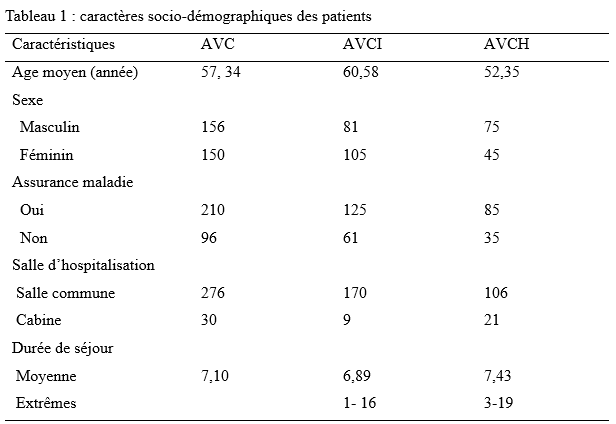 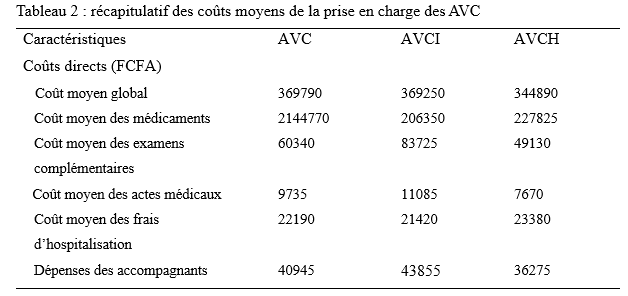 INTRODUCTION Selon le National Pressure Ulcer Advisory Panel (NPUAP) définir une lésion cutanée d’origine ischémique liée à une compression des tissus mous entre un plan dur et les saillies osseuses (2, 10). La prévalence des escarres est en augmentation dans plusieurs régions du monde (15). En France, sa prévalence était estimée à 8,4% en 2014 (4). Et en Afrique, une Méta-analyse réalisée en 2020 montrait que la prévalence ponctuelle des escarres était de 11% en Afrique (3). De plus, malgré l’augmentation des connaissances médicales et de nouvelles préventions et traitements efficaces, l’escarre reste une pathologie courante et débilitante qui représente un énorme fardeau pour les personnes touchées, les soins de santé, les systèmes et coûts socio-économiques (11, 15). La plupart des études menées sur les escarres dans le monde, sont axées sur la prévalence et l’incidence des escarres (4, 7, 15). D’autres études se sont intéressées aux facteurs de risque et à la prévention des escarres et à sa prise en charge (1, 6). Peu de données sont retrouvées dans la littérature sur la mortalité hospitalière liée aux escarres. En neurologie du fait du handicap des patients, ceux-ci pourraient être exposés à l’alitement prolongé et éventuellement au risque de survenu d’escarre. Mesurer son ampleur dans un service tel que la neurologie et en évaluer son impact fourniraient des indicateurs pertinents de décision en santé publique. Les escarres pourraient être significativement liées à la mortalité et prolongeraient la durée d’hospitalisation des patients hospitalisés au service de neurologie. Nous avons ainsi réalisé cette étude afin d’évaluer la mortalité et la morbidité ainsi que les déterminants des escarres en hospitalisation de neurologie. MATERIEL ET METHODE Il s’est agi d’une étude cohorte, prospective portant sur tous les patients hospitalisés du 1er janvier 2024 au 30 juin 2024 au service de neurologie du CHU de Cocody à ABIDJAN. Sa capacité d’accueil est de 37 lits. Il est subdivisé en 2 sous-unités soit une de neurologie générale et une neurologie vasculaire. Ont été inclus dans l’étude tous les patients hospitalisés durant la période d’étude. Les différentes variables étudiées étaient les données sociodémographiques (l’âge, le sexe, la profession, le niveau scolaire, le statut matrimonial), les données cliniques (le motif d’hospitalisation, les antécédents, la température, le tour de taille, le score prédictif de survenue d’escarres BRADEN (cette échelle comprend six items tels que la perception sensorielle, l’humidité, l’activité, la mobilité, la nutrition, la friction et le cisaillement. Chaque item est noté de 1 à 4 sauf l’item friction et cisaillement qui est noté de 1 à 3. Le score total de cette échelle est de 23. Plus le score bas, plus le risque de survenu d’escarre est élevé), les syndromes neurologiques à l’admission, le diagnostic retenu, le type de complication de décubitus, le siège de l’escarre, le stade de l’escarre, la dimension, le délai d’apparition de l’escarre), les données biologiques (la glycémie veineuse, le taux d’hémoglobine, la CRP, l’hémoculture, la procalcitonine), les données thérapeutiques et évolutifs (le type de matelas, la présence de coussin, l’intervalle d’immobilisation, la fréquence de nettoyage de l’escarre, les moyens de prise en charge des escarres, l’évolution en cours d’hospitalisation, la durée d’hospitalisation). Les variables quantitatives ont été exprimées par leur moyenne ± écart type ou par leur médiane ± étendue. Les variables qualitatives quant à elles ont été exprimées par leur effectif et proportion. L’analyse statistique a été faite à l’aide des tests de Chi2 et de Ficher avec un seuil de significativité p ˂ 0,05. RESULTATS Sur les 221 patients inclus, 57,9% étaient des femmes, avec une moyenne d’âge de 53 ans et un sex ratio de 0,7 (tableau I). Le déficit moteur et le trouble de la vigilance étaient les motifs d’hospitalisation les plus retrouvés. Les patients avaient un déficit moteur sévère (plégie) dans 68,6% des cas et un trouble de la vigilance avec un score de Glasgow inférieur ou égal à 10 dans 16,5% des cas (tableau II). Les patients qui avaient un risque élevé ou très élevé à l’échelle de BRADEN ont eu des escarres dans 65,2% des cas (figure 1). L’escarre était présente chez 37 des patients soit une prévalence de 16,7%. Chez les patients n’ayant pas d’escarre à l’admission, l’incidence des escarres en cours d’hospitalisation était de 07,1%. Elle se localisait dans 59,5% des cas au niveau du sacrum (tableau III). Le stade III était retrouvé dans 54%, suivi du stade II (37,84%) et le stade I représentait seulement 2,7% des patients (tableau IV). Parmi l’ensemble de nos patients ayant une anémie, 51,9% avaient des escarres (figure 2). Le sérum physiologique ou chlorure de sodium à 0,9 % était utilisé pour le nettoyage des escarres chez 36 sur 37 patients ayant des escarres (tableau V). La durée moyenne d’hospitalisation des patients sans escarres était 10,2 jours avec un maximum de 21 jours et celle des patients avec escarres était de 15,4 jours avec un maximum de 31 jours (figure 3). Tous les patients avec ou sans escarres qui avaient un risque très élevé à l’échelle de BRADEN étaient décédés (tableau VI). Les patients ayant une escarre sont décédés dans 37,8% des cas et ceux sans escarre sont décédés dans 11,9% des cas. La présence d’escarre était significativement associée au décès et augmentait de plus de 3 fois le risque de mortalité chez nos patients (tableau VII). Le décès est également lié significativement avec l’échelle de Braden (tableau VII). DISCUSSION Ce travail a présenté l’impact des escarres chez 221 patients hospitalisés en neurologie. Il a objectivé que sur l’ensemble des patients, la prévalence des escarres était de 16,7%. Cependant, l’incidence de survenue des escarres en cours d’hospitalisation chez les patients était de 07,1%. Cette incidence était conforme aux données de la littérature où l’incidence variait de 0,4% à 38% en fonction des services d’hospitalisation (9, 14, 15). Cette incidence, est relativement plus faible que celle retrouvée en Europe en 2007, dans une étude multicentrique, incluant plusieurs pays où l’incidence des escarres des patients de neurologie était de 15,1% (14). Cela pourrait s’expliquer par le jeune âge relatif de nos patients et par le fait que notre service s’est doté depuis décembre 2023 de matelas anti escarre à air. L’incidence des escarres augmentait avec l’âge avec un pic de fréquence situé entre 51 et 65 ans. Ce résultat corrobore avec celui de Oukit au Maroc qui rapportait un âge moyen de 54,8 ans (11). Tandis que la littérature occidentale rapportait un pic de fréquence situé entre 76 et 84 ans (13). Ceci pourrait s’expliquer par le fait qu’en Afrique, la population est relativement jeune. Le sexe féminin était discrètement plus représenté avec un sex-ratio de 0,7. Ce résultat était différent du résultat avancé par Briggs et al, lors d’une étude menée au Royaume-Uni qui notait une légère prédominance masculine (5). Cependant dans la littérature la prédominance de sexe varie d’une étude à l’autre (7, 8, 12, 13). Les patients qui avaient un risque élevé ou très élevé à l’échelle de Braden ont eu des escarres dans 65,2% des cas. Ce qui était conforme aux données de la littérature (1, 13). En effet, l’échelle de Braden fait partie des échelles d’évaluation du risque d’escarre. C’est une échelle simple, facile à utiliser, dont la sévérité est corrélée au risque de survenue d’escarre. La présence d’escarre prolongeait la durée d’hospitalisation de nos malades. En effet la durée moyenne d’hospitalisation des patients, avec ou sans escarre était de 11,1 jours ; celle des patients sans escarres était de 10,2 jours avec un maximum de 21 jours, et celle des patients avec escarres était de 15,4 jours avec un maximum de 31 jours. Ce qui était conforme aux données de la littérature où la présence d’escarre prolongeait la durée d’hospitalisation (5, 11). En effet, Oukit dans son étude a trouvé une durée moyenne d’hospitalisation de 19,6 jours (11). Jiang et al en Chine dans leur étude, retrouvaient une durée d’hospitalisation majoritairement comprise entre 6 et 30 jours (79,49%) chez les patients avec escarre (8). Plusieurs raisons pourraient expliquer cette différence. Premièrement, l’escarre est une complication de décubitus qui entraine une prise en charge supplémentaire et sa guérison est très difficile. Secondairement, le stade III était le stade le plus fréquent (54%), suivi du stade II (37,8%) et le stade I représentait seulement 2,7% des patients ayant des escarres. Enfin, la localisation sacrée était la localisation la plus fréquente des escarres (59,5%) ce qui rend la prise en charge difficile du fait des difficultés de décharge. Le taux de décès des patients avec des escarres était de 37,8% contre 11,9% de décès chez les patients sans escarres. La présence d’escarre était significativement associée au décès et augmentait de plus de 3 fois le risque de mortalité chez nos patients. Les résultats étaient conformes aux données de la littérature. En effet, selon la littérature la présence d’escarre multiplie par 2 le risque de mortalité des patients (13). Ce taux élevé de décès chez les patients avec escarres dans l’étude pourrait s’expliquer par le fait que 59,4% des patients avaient des escarres au stade III ou IV et n’avaient pas, par conséquent, un protocole de traitement adapté. De plus la présence des escarres était responsable d’autres complications telles que : le sepsis (5% des cas), l’anémie (51,9% des cas). Cependant d’autres déterminants de mortalité ont été retrouvés dans notre étude. Il s’agissait de la présence d’un risque très élevé à l’échelle de Braden et d’un trouble de la vigilance avec un score de Glasgow inférieur ou égal à 10. En effet, l’échelle de Braden était significativement associée au décès et tous les patients avec ou sans escarres qui avaient un risque très élevé à l’échelle de BRADEN étaient décédés. De même les patients avec un score de Glasgow inférieur ou égal à 10 avaient un risque élevé de décès. CONCLUSION Cette étude prospective est l’une des rares études à évaluer des escarres sur le devenir des patients hospitalisés dans un service de neurologie en Afrique noire. Même si elle comporte certaines limites en rapport avec la petite taille de l’échantillon, l’étude a montré que la présence d’escarres chez les patients hospitalisés était corrélée à un prolongement de la durée d’hospitalisation, à un risque élevé de décès et à la survenue d’autres complications telles que le sepsis et les anémies. Il faudrait donc mettre l’accent sur les mesures de prévention car ceux-ci diminuent considérablement l’incidence des escarres. 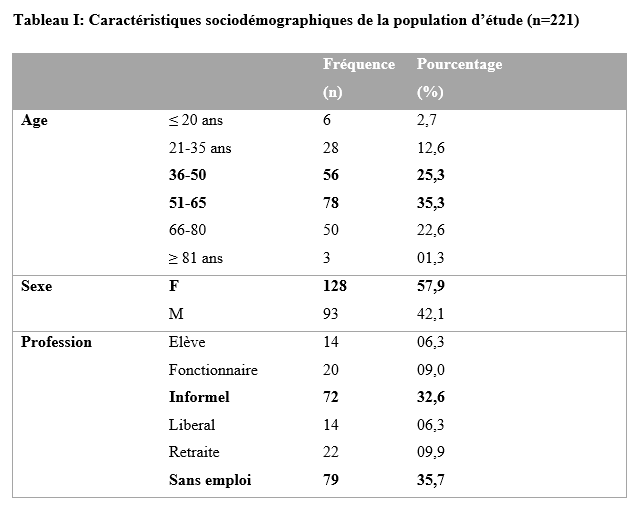 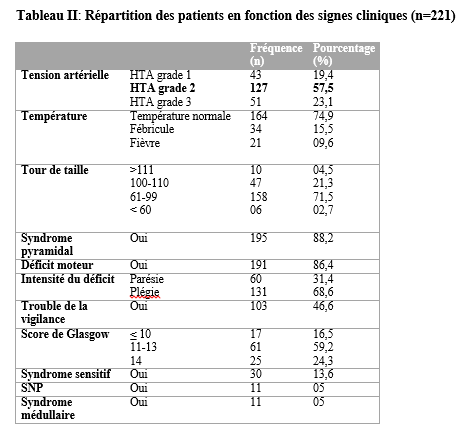 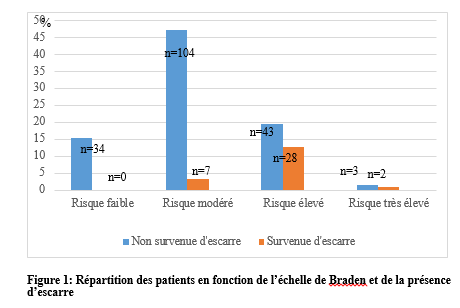 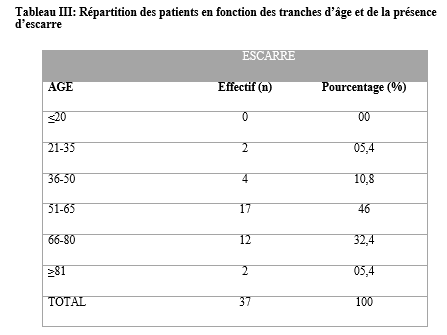 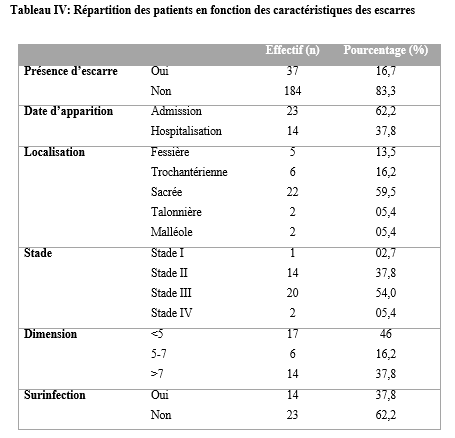 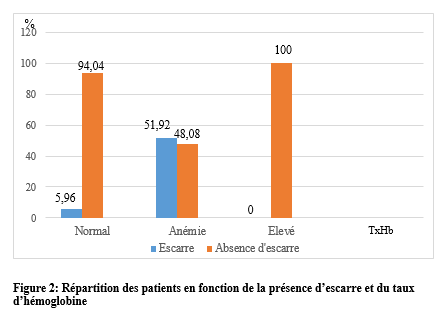 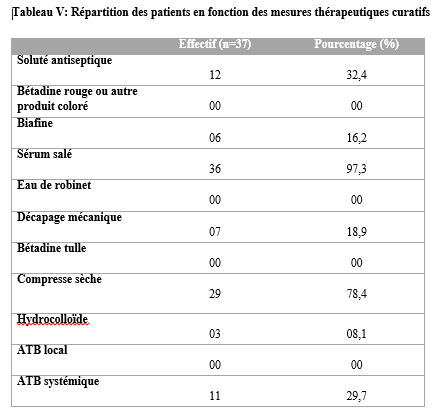 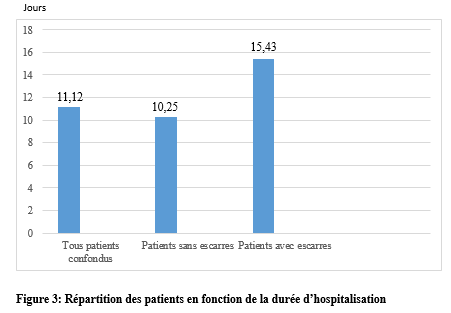 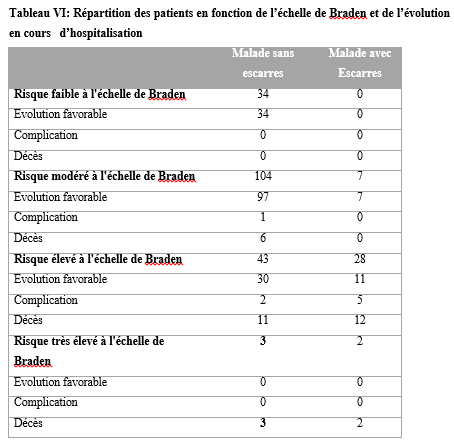 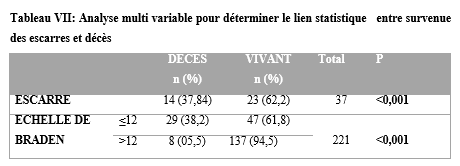 Conflit d’intérêt : aucun Articles récents
Commentaires récents
Archives
CatégoriesMéta |
© 2002-2018 African Journal of Neurological Sciences.
All rights reserved. Terms of use.
Tous droits réservés. Termes d'Utilisation.
ISSN: 1992-2647